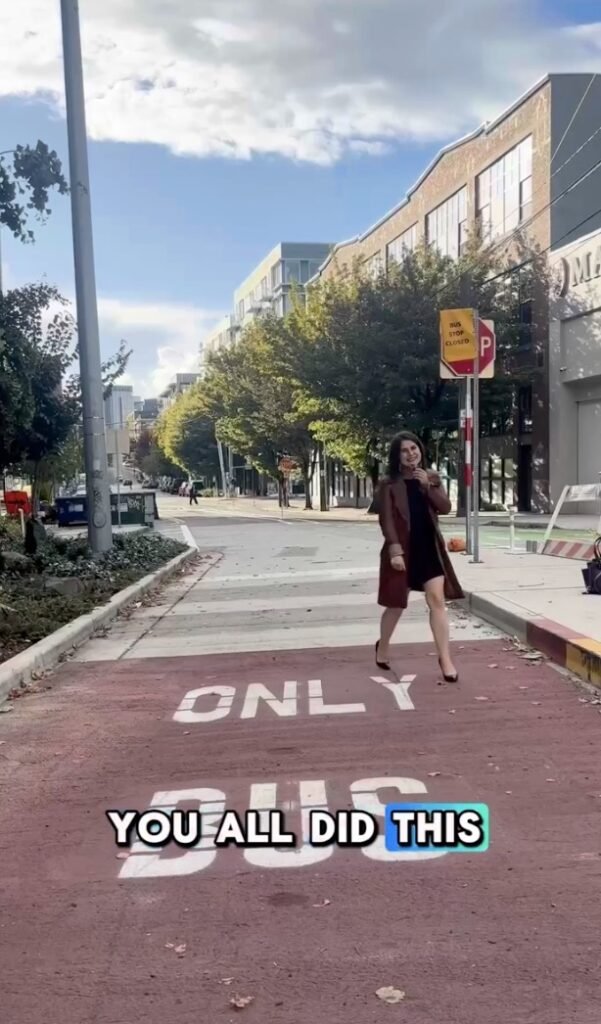Rinck in a video celebrating the SDOT reversal of its reversal on E Union earlier this month.
The city’s reversal on a plan to remove a red paint bus lane from a few-block stretch of Capitol Hill has become a movement.
Wednesday, Seattle City Councilmember Alexis Mercedes Rinck was on her home neighborhood turf near the busy triple intersection of 12th, Union, and Madison to announce a “coalition-backed initiative” she says will push for improving — and, apparently, preserving — bus lanes throughout the city.
“For too long our city has missed the moment to ensure frequent and reliable bus service on some of our most used bus corridors. Now is the time to fix these longstanding issues head on,” Rinck said in the announcement. “I’m proud to stand with transportation advocates to find a new way forward for Seattle’s bus riders.”
The citywide council member was joined by representatives from Transportation Choices Coalition, Amalgamated Transit Union 587, Transit Riders Union, Aurora Reimagined Coalition, Fix the L8, and Central Seattle Greenways at a stop for the Metro Route 2 bus as traffic roared nearby the busy Capitol Hill intersection along the RapidRide G corridor.
CHS reported here earlier this month as the Seattle Department of Transportation said crews were in the process of reversing a small stretch of E Union changes made under the RapidRide G project, including removing the red-paint bus lane through the area where poor design had left Metro needing to detour the block. After advocates spoke out against the whipsaw decision, SDOT announced it was reversing the reversal and would be installing a pedestrian signal that would make the stretch of E Union safe for Metro’s Route 2 to return to the block.

Wednesday’s press conference at 12th and Union
Now Rinck, whose solid performance in the Primary Election has her positioned for another victory this November despite a spirited Capitol Hill challenger, is joining with transportation advocates to push for a “Better Bus Lanes” campaign to take what happened around Route 2 and extend the effort to other important and challenged lines on Denny Way, Aurora, and Rainier Ave:
The Better Bus Lanes Campaign prioritizes three near-term safety and reliability improvements on these streets for riders:
- Two-way bus lanes on Denny Way from Queen Anne Avenue to Stewart St.
- Make the temporary 24/7 bus lanes on Aurora Avenue permanent, expand safe crossings, and move Seattle towards achieving Vision Zero.
- Expand bus reliability progress on Rainier Avenue in anticipation for RapidRide R around Mount Baker Station while promoting safety for all.
More priorities will likely follow.
On Denny, Route 8 is a Seattle transit legend in poor performance. “Can they ever really fix the 8?” CHS asked in June as we reported on the challenges. Metro data shows the route to be one of the most used bus routes in the city. But the route consistently fails to meet Metro’s 80% on-time performance goal. During rush hour last summer, its on-time rate dipped below 40%.
SDOT said it was making spot improvements — paving, sidewalk repair, pedestrian ramps, signage — earlier this year. Advocates are asking for more.
“Piloting bus lanes along Denny Way allows the city to test new ways to ensure Route 8 can be as reliable as possible on one of our few east-west bus routes,” Rinck’s office said in the announcement.
The groups may have their work cut out for them. With so much of SDOT’s current-day investments centered around paint, not concrete, city officials face nearly constant temptation to tinker, tweak, and remove.
Mayor Bruce Harrell is not immune. Tuesday night at the Capitol Hill Community Council/First Hill Improvement Association Mayoral Debate, Harrell revealed his office is looking at removing more elements installed during construction of the $144 million RapidRide G line. During the debate, Harrell said he wants to answer concerns from neighborhood businesses and revisit decisions that changed some lanes and eliminated left-hand turns around the year-old RapidRide line on Madison between the waterfront and Madison Valley across First Hill and Capitol Hill to “help small businesses recover” and clear “some bumps along the way” of the bus rapid transit line.
Preserving these elements designed to help speed G Line service may be the next Better Bus Lanes battle on Capitol Hill.
Rinck says the Better Bus Lanes push will start with “assessing budgetary options, code changes, and partnership with SDOT to ensure buses are serving the riders of Seattle.” Rinck is bringing forward a Statement of Legislative Intent “to work with SDOT through the budget process to achieve these goals.”
The council is currently deliberating the 2026 budget through November.
 $5 A MONTH TO HELP KEEP CHS PAYWALL-FREE
$5 A MONTH TO HELP KEEP CHS PAYWALL-FREE
Subscribe to CHS to help us hire writers and photographers to cover the neighborhood. CHS is a pay what you can community news site with no required sign-in or paywall. To stay that way, we need you. Become a subscriber to help us cover the neighborhood for $5 a month — or choose your level of support 🖤




